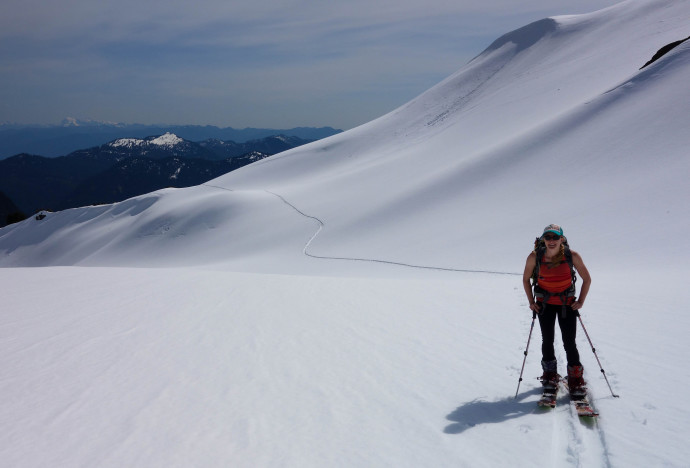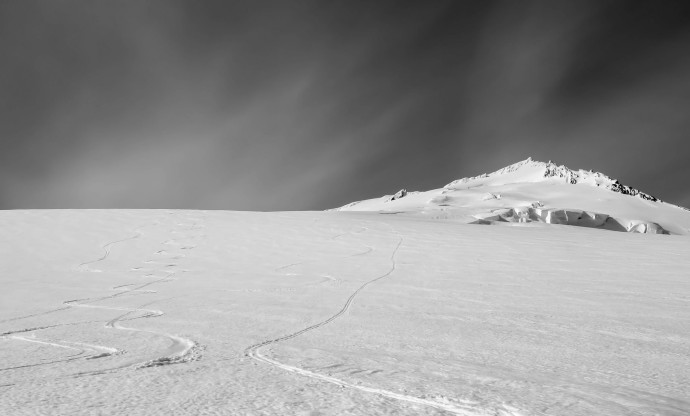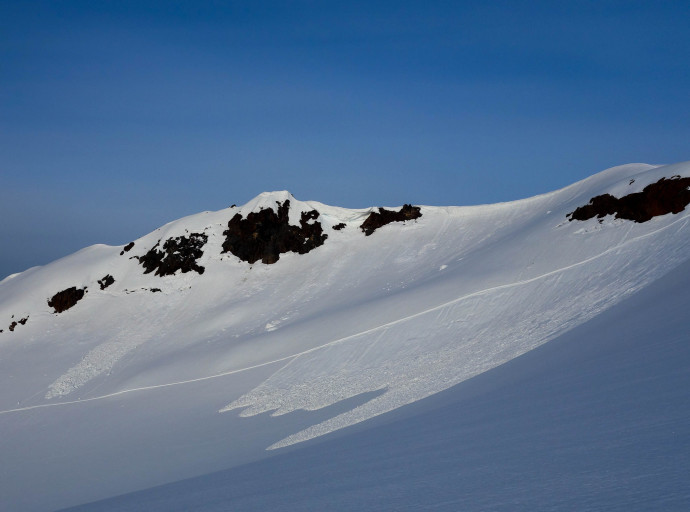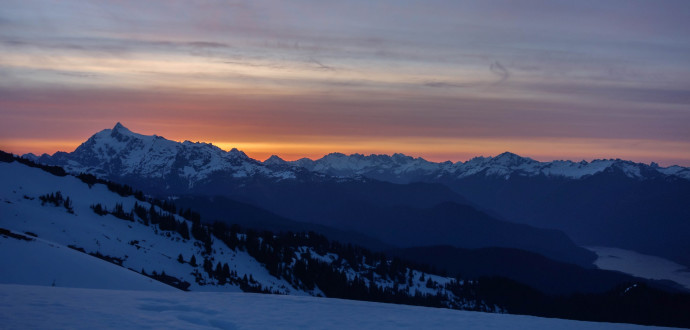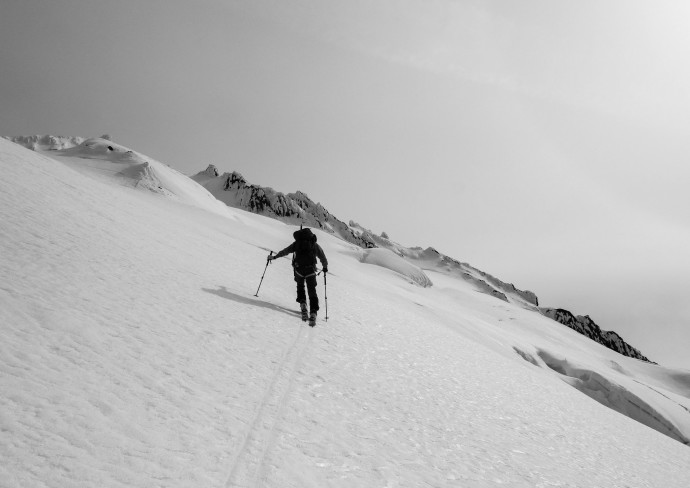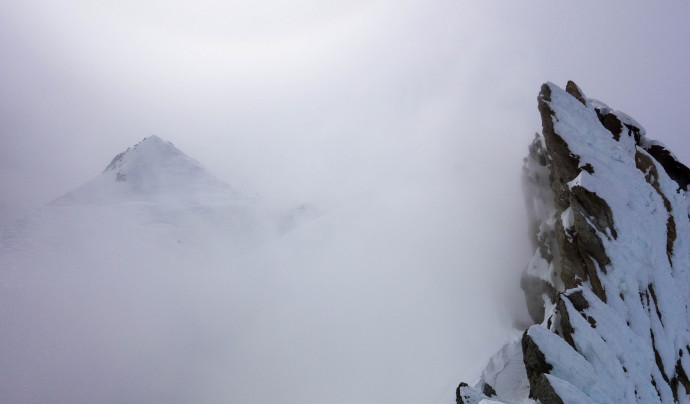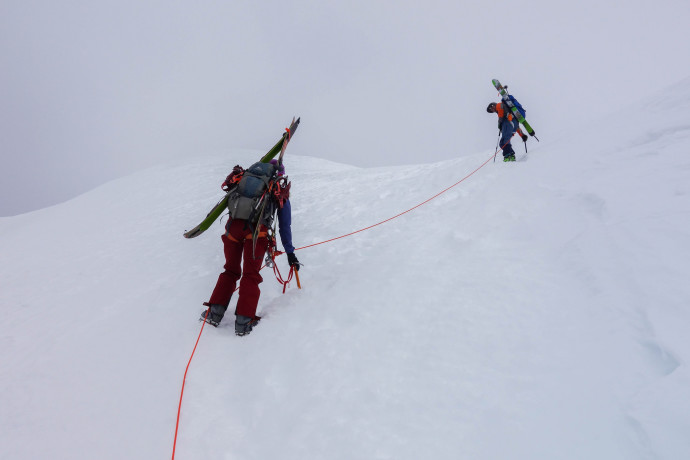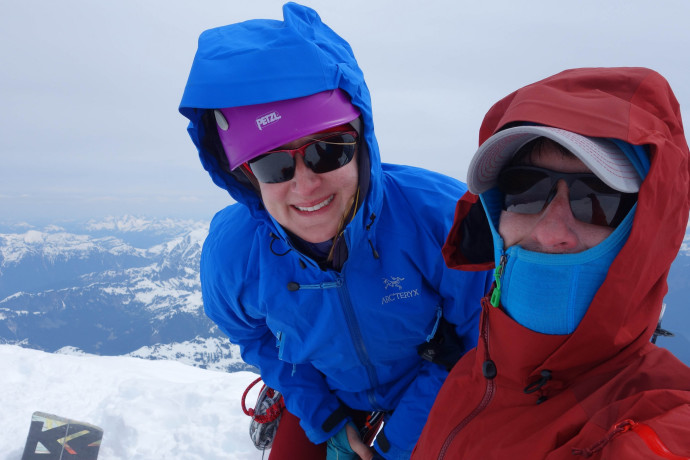Mt. Baker Ski Ascent/Descent- Squak Glacier Route
Not long after Katy and I got married, we met up with our fellow PNW-Hoofers for a beer at one of our favorite watering holes. We thought it’d be just another weeknight drinking yummy brews, but it was strangely different: most of the time we can barely make schedules align for a weekend, let alone for a weeknight, and here were 6 of our friends and us all around a table.
We sat down, ordered beers, and a couple minutes later an orange envelope was placed in front of Katy and I.
We opened it and found an unexpected and amazing wedding gift: a guided trip up Mt Baker with Oyvind from North Coast Guides. We were stoked!
Some celebratory beers and a bunch of logistics emails later, we were driving north on the morning of May 9th.
After meeting up and doing a quick gear check, we found ourselves at the end of FS-13 and starting up the Scott Paul Trail. The plan was to make a high camp near or below Crag View and take the Squak Glacier route up to the summit.
We hiked with skis on our packs and hit snow at about 5200′. Transitioning to skis, we started skinning and found a nearly-dried out camp on a ridge at about 5,800′. A few minutes with the shovel and we were good to go: we wouldn’t even have to camp on snow. Warmth and luxury!
It was still early at this point, so after a sun-warmed nap for about an hour, we geared up for a quick tour to check out the route and snow conditions. It was warm and sunny with a cool breeze: not a bad way to be spending a weekend in the alpine.
We called it at just about 8,000′, on the fun rollers of the lower Squak Glacier. A few people who we saw skiing past us reported great conditions, and the glacier itself was still very skiable. We transitioned to downhill mode and cruised back to camp in smooth but heavy late afternoon corn.
There was a little bit of excitement when, about 200′ above camp traversing across a steep slope, we each let off a considerable amount of slough that picked up speed and settled on the bottom of the slope. It looked like, sounded like, and felt like a lose-wet slide, but was different in that it was sluffy point releases from our skis.
We were comfortable with the conditions due to their predictability, but it was still slightly uneasy seeing how touchy the sun-affected upper layers of the snowpack were.
We haven’t seen slough like this before, and it was a good learning experience about spring volcano skiing.
The next morning, we got a ~5am start in a momentary glow of mountain sunrise. It was cloudy for a few hours, but the clouds quickly burnt off for our skin up.
The snow refroze overnight, and we were excited to finally try out some crampons for our splitboards. They made a huge difference — icy, steepish traverses that would have previously made us grind our teeth and curse under our breath were tamed and almost, dare I say, easy. We cruised up past our previous day’s high point, took a snack break, and continued moving up towards the summit.
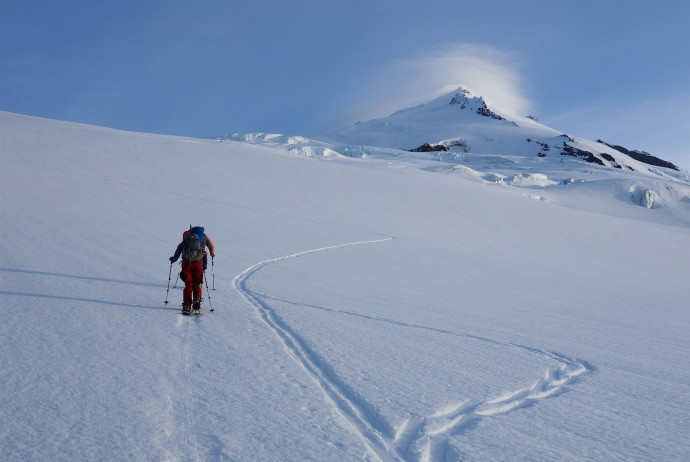
Skinning up on the Squak Glacier during our Summit Bid. The lenticulars around Sherman Peak (pictured) and Grant Peak (true summit, not visible here) foreshadowed how windy it was on the summit.
At about 9,000′ we started to see our first bit of sagging and small crevasse openings. In the late summer (likely early summer this year), the Squak tends to be pretty open and crevassed as it flows south and east over bulging and rolling terrain. At this point though, there was still plenty of snow filling in the cracks. It was prime time to ski up and down this route with ample daylight.
After navigating a few more crevasses, we were nearing the base of the Roman Wall and the saddle at the crater rim between Sherman Peak and the Roman Wall. The previous day we discussed an alternative ski line: ski down into the crater, then skin out and ride back down to camp via the Squak. This way we’d avoid skiing down the Roman Wall and also get to check out an awesome and aesthetic ski route off the summit.
We walked to the crater rim to check out what conditions would look like for that alternative.
The views here were surreal: the steam from the crater rose up and over the rim, occasionally surrounding everything in a dense fog. Every few seconds we’d see the other side of the crater and check out our potential line. It looked steep, with a wall of blue ice on looker’s left and cliffs on lookers right. On the bright side, it was low consequence, with the steep section smoothing out to the bottom of the crater. It looked great. We turned around, roped up, and started heading towards the summit.
Getting up the Roman Wall was step-after-step of steep cramponing in good, consolidated snow-steps. I was feeling slightly beat from the elevation, but some snacking and water at the base of the wall was helping significantly.
We made good time and before we knew it we were topped out on the wall, walking towards Baker’s summit – Grant Peak.
We paused for a minute at the summit, enjoying sweeping 360 degree views of the surrounding mountains, but otherwise we immediately began transitioning to downhill so that we could get out of strong summit winds.
We skied off of Grant Peak, but instead of continuing on back towards the Roman Wall, we took a sharp left and started heading down a steep rollover. The snow in this section was great — it was protected from the wind and was just softening up from the morning’s refreeze. It made for awesome, secure, steep turns. In some points it almost felt like something we’ve been missing all season: our beloved heavy cascade-concrete powder.
We arrived at the bottom of the crater after whooping and hollering down the descent.
Looking back at our tracks, it looked epic: steep, aesthetic, and visually committing (though much more secure than it looked).
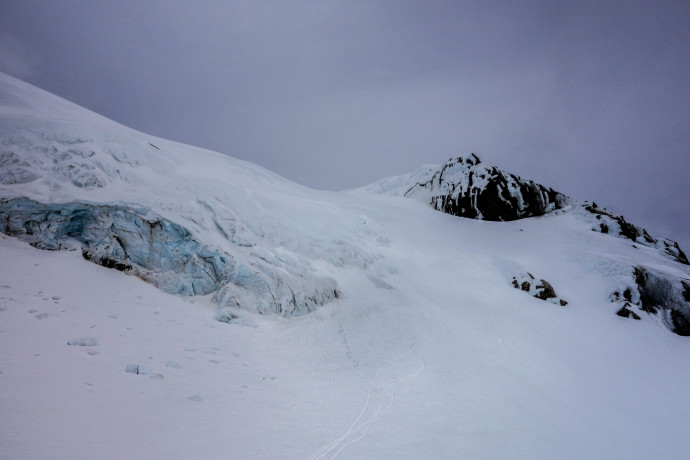
Our ski line from Grant Peak (Baker Summit, upper right). You slightly see our tracks right of center, between the ice-cliffs and the cliffs/rocks.
All that was left was a short climb back to the rim and a 3,500′ descent on great corn back to camp before we’d have to slog back to the car.
The ski back to camp was big, fast, wide turns over the glacier’s rollers on smooth corn. It was kept interesting with a few more depressions we were suddenly aware of, but aside from that we were back at camp before we knew it with huge grins on our faces.
After packing up camp, the day’s work started to get to me for the first time. Once off the snowfield, I was feeling a nagging pain in my knee. I stayed in the back of our trio, trying to tread carefully on it.
We cranked out the last couple miles and got back to the car in one piece. It was a pretty awesome weekend spent in the alpine : glorious views excellent turns down some incredible terrain.
Huge thanks to Oyvind and North Coast Guides for leading the way, and for our awesome friends Christian, Meredith, Matt, Greta, Brad, Brittany, Kyle, and Courney for the kickass gift.
Another Cascade Volcano crossed off the list!!


